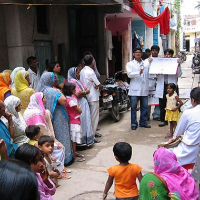Analysing a Million Premature Deaths in India
 Researchers conduct field visits to gather details of premature deaths (photo: India TV)
Researchers conduct field visits to gather details of premature deaths (photo: India TV)
The majority of deaths in India occur at home and without medical attention, like in most low- and middle-income countries. Yet estimates of the causes of death are generally based on the minority of people who die in hospitals and under medical supervision.
An ongoing study has been investigating one million deaths in the country since 1998 to get a better understanding of the reasons for premature mortality. Its findings are now being used by the government and health officials to take action against preventable deaths.
Conducted by the Centre for Global Health Research, Toronto, in collaboration with the Registrar General of India, the Million Death Study (MDS) is one of the largest studies of its kind in the world.
Over 800 government researchers visit households where a death has occurred to meet relatives and conduct a ‘verbal autopsy’ by asking what happened before their death. This verbal testimony often throws up clues that can be used to assign the cause of death.
The trained researchers ask about symptoms like unconsciousness, breathlessness or fever leading up to the death, as well as lifestyle questions about smoking, drinking and diet.
This information is then passed on to two doctors who independently try to assign the cause of death. If their conclusions do not tally, the case is passed to a third senior physician for analysis.
According to BBC, knowing what is killing people is vital - it helps save lives by ensuring public health money is spent on the right things.
60,000 homes per year have been visited over the course of 14 years and MDS is set to reach the millionth death later this year. After completing the survey, it will take another year or two for all the deaths to be analysed.
"India has about nine million deaths (every year), most of which occur at home and in rural areas," said Prof Prabhat Jha, who leads the study.
By looking into deaths at home as well as those in hospitals, the MDS is building up a comprehensive picture of what Indians are dying of.
Its early findings have already made an impact. In 2010 the team controversially found that malaria deaths in India were 13 times higher than WHO estimates. The WHO's India Office disputed the MDS’ figures, saying that fever symptoms are common to other illnesses.
The study has also found that smoking is a major cause of death in India – its figures show that a male cigarette smoker loses a decade of life on average.
According to Jha, this prompted the new administration to raise taxes on cigarettes by 11% to 72% in its maiden budget last week. It is estimated that this hike could save nearly one million lives.
Overall, the MDS estimates that the four most significant causes of death for Indians aged 30-69 years are cardiovascular disease, chronic respiratory disease, tuberculosis and cancer.
Dr Sanjay Kinra, a public health expert from the London School of Hygiene and Tropical Medicine who is not involved in the study, told BBC that the MDS could help improve India's health.
But the ultimate aim, Kinra said, should be for the government to develop a stronger civil registration system to record the details of all deaths, not just a sample as in this study.
- Top Stories
- Controversies
- Where is the Money Going?
- India and the World
- Appointments and Resignations
- Unusual News
- Latest News
- India College Chain’s Expansion into U.S. Draws Opposition from Massachusetts Officials over Quality of Education
- Milk Shortages in India Tied to Release of New Movies Featuring Nation’s Favorite Stars
- Confusion Swirls around Kashmir Newspaper Ban in Wake of Violent Street Protests
- Polio-Free for 5 Years, India Launches Vaccine Drive after Polio Strain Discovery
- New Aviation Policy Could Increase Service, Lower Ticket Prices






Comments